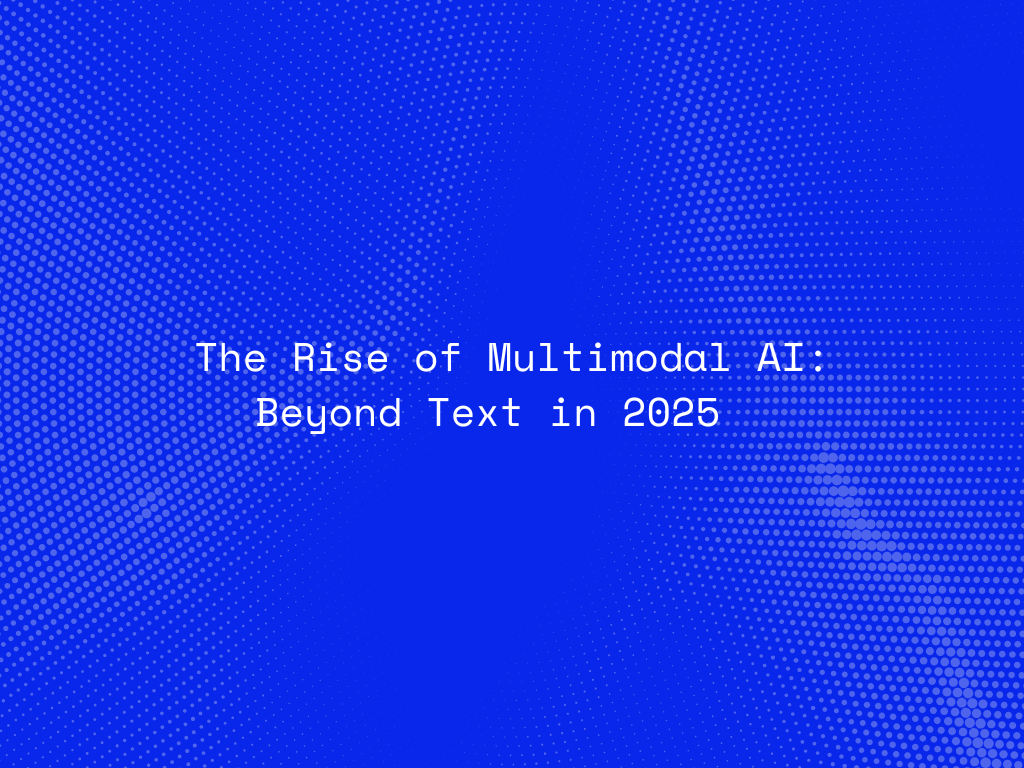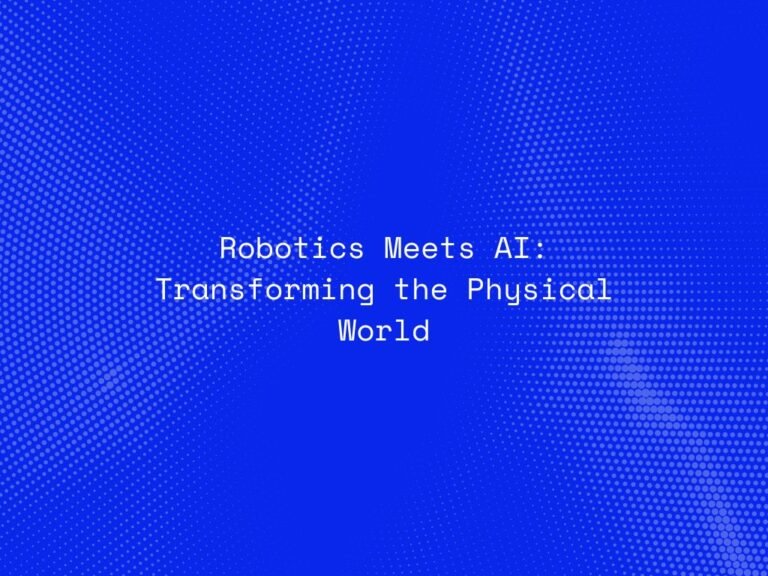As artificial intelligence continues to advance, multimodal AI is emerging as a key innovation that goes beyond traditional text-based models. Unlike conventional AI systems that rely on a single type of input, multimodal AI integrates and processes multiple data types, including text, images, audio, video, and sensor data.
In 2025, multimodal AI is transforming industries such as healthcare, e-commerce, robotics, content creation, and autonomous systems, enhancing human-computer interactions, enabling deeper data understanding, and driving intelligent automation.
This blog explores the rise of multimodal AI, its impact across industries, and the key innovations shaping its future.
What is Multimodal AI?
Multimodal AI refers to AI systems that can process and understand multiple forms of input simultaneously, such as text, images, audio, and video. This capability allows for richer contextual understanding and more accurate decision-making compared to unimodal AI, which relies on a single data source.
For example:
- A traditional chatbot understands and responds based only on text input.
- A multimodal AI assistant can interpret spoken words, facial expressions, and gestures, making interactions more natural and effective.
Leading AI models like GPT-4, Google Gemini, and Meta’s ImageBind already demonstrate multimodal capabilities. As these models continue to evolve, their applications will expand across various sectors.
The Evolution of Multimodal AI
Multimodal AI has evolved over the years through continuous advancements in machine learning and deep learning. Some key milestones include:
- Early 2010s: AI was primarily unimodal, focusing on text processing (e.g., chatbots), image recognition, or speech recognition separately.
- 2015-2020: The rise of deep learning enabled models to combine text and images, leading to improvements in areas like image captioning and visual question answering.
- 2021-2023: Advanced multimodal models like DALL·E, CLIP, and Gemini integrated multiple data types, allowing AI to generate and understand images, videos, and audio based on textual input.
- 2024-2025: The introduction of large multimodal models (LMMs) and improvements in real-time multimodal reasoning are making AI more powerful and adaptable in real-world applications.
This evolution has enabled AI to interact with the world in a more human-like manner, improving decision-making and automation.
Key Technologies Driving Multimodal AI in 2025
1. Transformer-Based Architectures
Models like GPT-4, Google Gemini, and Meta’s ImageBind utilize transformers to process multiple modalities, enabling seamless integration of text, images, and audio.
2. Vision-Language Models (VLMs)
VLMs like CLIP and BLIP-2 link textual and visual representations, allowing AI to generate captions, describe images, and perform visual reasoning.
3. Self-Supervised Learning (SSL)
SSL enables AI to learn from vast amounts of unlabeled multimodal data, reducing reliance on expensive, manually annotated datasets.
4. Generative AI for Multimodal Content
Tools like DALL·E 3, Runway ML, and Google Imagen generate high-quality images, videos, and synthetic audio from textual prompts.
5. Edge AI and On-Device Processing
Advancements in edge computing and AI hardware allow multimodal AI models to run on devices like smartphones, AR glasses, and IoT systems, enabling real-time, offline processing.

Applications of Multimodal AI
1. Healthcare and Medical Diagnostics
Multimodal AI enhances medical imaging analysis, patient record interpretation, and real-time health monitoring.
- AI-powered radiology systems analyze X-rays, MRI scans, and medical history together for improved diagnostics.
- Wearable devices use sensor data, speech input, and visual cues to detect health conditions in real time.
2. AI-Powered Virtual Assistants
AI assistants are becoming more context-aware by integrating speech, facial expressions, and text inputs.
- AI can analyze spoken commands and emotions to tailor responses.
- Chatbots equipped with multimodal AI provide more personalized and interactive customer service.
3. Retail and E-Commerce
Retailers use multimodal AI for personalized shopping experiences and product recommendations.
- AI analyzes voice search, browsing history, and image uploads to suggest relevant products.
- Virtual try-on technology enables customers to see how clothes or accessories look on them in real time.
4. Autonomous Vehicles and Robotics
Self-driving cars and AI-powered robots rely on multimodal AI for improved navigation and decision-making.
- AI processes camera feeds, sensor data, and voice commands for safe and efficient driving.
- Robots interpret gestures, speech, and environmental data to interact seamlessly with humans.
5. AI-Generated Content and Media
Multimodal AI is revolutionizing video editing, automated content creation, and synthetic media production.
- AI can generate high-quality videos from text prompts.
- Music AI models compose original soundtracks based on mood and lyrics.
6. Security and Fraud Prevention
Multimodal AI strengthens security by analyzing biometric data, voice authentication, and behavioral patterns.
- AI-powered fraud detection systems identify unusual transactions based on multimodal input.
- Advanced deepfake detection models help prevent identity fraud and misinformation.
Challenges and Ethical Considerations
Despite its potential, multimodal AI presents several challenges and ethical concerns:
- Data Privacy and Security: AI models require massive datasets, raising concerns about data ownership, consent, and misuse.
- Bias and Fairness: Multimodal models can inherit biases from their training data, leading to unintended discrimination.
- Computational Costs: Training large multimodal models demands significant resources, making them expensive and energy-intensive.
- Misinformation Risks: AI-generated content can be misused for fake news, misinformation, and fraud, requiring strict regulations.
Future Trends: What’s Next for Multimodal AI?
1. Real-Time Multimodal Interaction
AI assistants will become fully interactive, processing voice, gestures, and facial cues simultaneously for natural conversations.
2. AI-Powered Augmented Reality (AR) and Virtual Reality (VR)
Multimodal AI will enhance AR/VR experiences by enabling intuitive interactions using speech, touch, and movement.
3. Energy-Efficient AI Models
Efforts are being made to develop lightweight, faster, and more sustainable multimodal AI models that can run efficiently on consumer devices.
4. AI in Space Exploration
NASA and space tech companies are exploring multimodal AI for analyzing satellite imagery, sensor readings, and communication data to improve space missions.
Conclusion
Multimodal AI is redefining the way artificial intelligence interacts with the world. By integrating text, images, video, speech, and sensor data, AI is becoming more intelligent, context-aware, and capable of real-world applications.
As businesses and researchers continue to push the boundaries of AI, ensuring ethical development, data security, and fairness will be critical to maximizing its potential. The rise of multimodal AI is not just a technological shift but a transformation in how we communicate, automate, and innovate.
The question is: How will you leverage it in 2025 and beyond?




